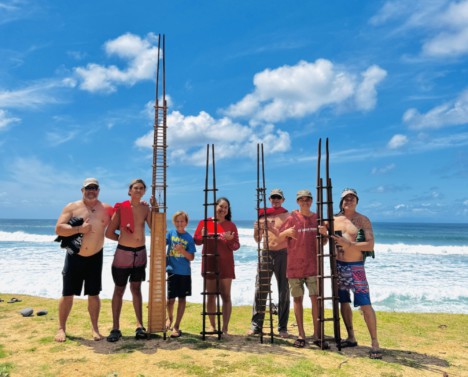Building Holua to ‘Ride in the Footsteps of the Ancestors’
By Catherine Cluett Pactol
Molokai residents gathered around as cultural practitioners and educators Mahi La Pierre and ‘Iliahi Doo unfurled a long roll of brown paper covered with sketches, names and dimensions. It’s a road map to building holua — ancient Hawaiian wooden sleds.
“These days are going to be like, laugh, cry, everything, and just pouring our time and energy into these things that our kupuna rode,” La Pierre told the Molokai participants of a three-day holua workshop.
La Pierre and Doo, of Oahu, visited the island last month to share their love and knowledge of holua. It was a sport of the akua and ali’i, in which brave kane and wahine rode narrow sleds that were between 7 and 18 feet in length, down a mountain track at speeds of up to 50 miles per hour.
“So imagine riding on a mile long kahua of stone, like 15 feet wide, and then putting something on it, like sugar cane flowers, to reduce friction,” explained La Pierre. “Some people say [it’s] ‘the Hawaiian extreme sport,’ so people died.”
The goal was to travel the farthest distance, riding at death-defying speeds with your face inches off the stone. There are ancient holua tracks across Hawaii, some with burial sites near them, said La Pierre.
But the Molokai residents gathered at the workshop were more focused on the building process.
Sitting around the brown paper spread in front of them – with hand drawings using a holua model at the Bishop Museum as a guide — they learned the names of holua elements. The pola form the platform; the keʻa are the crosspieces, and the kamaʻaloa are the runners.
Starting with rough-cut ‘ohia wood, they sanded the pieces smooth with hand tools, and rubbed them with coconut oil till they shone. Then they learned to lash them together — wrapping, crossing and pulling the twine to bring the sled pieces together.
“Two days ago we just had wood,” said La Pierre. “Now we have a vehicle to ride in the footsteps of our ancestors.”
Kanoelani Davis is a Molokai cultural practioner and executive director of Hoʻaka Mana, the nonprofit that hosted the workshop. For her, the holua creation process is a form of healing.
“To see the joy in people’s faces, to see the array of ages. We had people who were keiki all the way to kupuna that were doing the classes,” she said. “So witnessing just our community kind of come together was positive. And we had a lot of positive feedback — not only in their accomplishment of making the holua — but just how they felt, like inside, and it’s beautiful to be in a place where everybody is just positive.”
Throughout the process, participants found ways to connect with their kupuna and picture them doing the same thing.
“If we could imagine when was the last time someone in this area made one [holua] and what were they doing? Maybe your street was a holua slide!” laughed La Pierre, of Kamiloloa Heights, where the workshop was held.
La Pierre and Doo encouraged participants to ask questions.
“We still don’t know all the answers as to why,” said Doo. “Why is it this size? Why is it this skinny? Why is it all of this kind of stuff? But ask!” he said. “Because it’s kind of cool to know why kupuna did it. I know somebody asked, ʻDid the ali’i only do it?ʻ And from the stories we heard, yeah, but who knows? Somebody could have snuck around and because it looks fun, yeah? Like, ʻoh, I like do that,ʻ right?”
For participant Aulani Herrod-Perkins, it was a chance to learn as her ancestors did.
“We may not have all the answers, but we just try to figure them out — that’s what our kupuna did. They just tested them out, figured out what works, what doesn’t work, and we’re literally living like how our kupuna did. We try to live as Kanaka as we can, especially in this 21st century.”
13-year-old Kauluwai Yamashita said lashing was most memorable for him.
“Lashing was my favorite part, ‘cause I didn’t know how to lash before this and it was really cool getting to learn how,” he explained. “And now I’m thinking about making my own holua sled, ‘cause that would be really fun.”
Participants got a small taste of riding their newly-built holua, amid laughter and whoops of “hana hou!”
“When you ride, even though I personally have never experienced a very big hill, it’s just this exhilarating, getting to the mindset and just an inkling of what really happened [back then],” said La Pierre.
The two papa holua participants built will stay on Molokai to be used and shared.
“These holua, what I foresee with these are for the community to continue learning how to lash,” said Davis. “We can take them apart now and put them together. I hope that they bring folks, the participants, together… I’m hoping also, in the future, that this could be a component that they can learn and we can put people on the holua to actually master it to a point, if they decide to put holua into the Makahiki games here, we have people ready to go.”
Davis said she also plans to take the holua into classrooms to share the ancient sport and building process with keiki.
La Pierre, Doo and Davis said ultimately, they hope the workshop will encourage Molokai residents to continue to build, ride and create excitement around holua.
“That’s what our intention is — to make it normal, because it’s such a lost art,” said Doo.












Don't have a Molokai Dispatch ID?
Sign up is easy. Sign up now
You must login to post a comment.
Lost Password